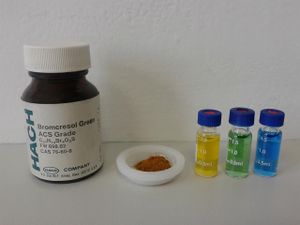Difference between revisions of "Bromocresol green"
(Created page with "{{Chembox | Name = Bromocresol green | Reference = | IUPACName = | PIN = | SystematicName = | OtherNames = 3,3′,5,5′-Tetrabromo-m-cresolsulfonphthalein <!-- Images --> | I...") |
|||
| (2 intermediate revisions by the same user not shown) | |||
| Line 2: | Line 2: | ||
| Name = Bromocresol green | | Name = Bromocresol green | ||
| Reference = | | Reference = | ||
| − | | IUPACName = | + | | IUPACName = 2,6-dibromo-4-[7-(3,5-dibromo-4-hydroxy-2-methyl-phenyl)-9,9-dioxo-8-oxa-9λ6-thiabicyclo[4.3.0]nona-1,3,5-trien-7-yl]-3-methyl-phenol |
| PIN = | | PIN = | ||
| SystematicName = | | SystematicName = | ||
| Line 136: | Line 136: | ||
===Disposal=== | ===Disposal=== | ||
| − | Adding a strong oxidizing solution, such as [[chromic acid]], [[Fenton's reagent]] or [[piranha solution]] will slowly break it down to carbon dioxide, water, sulfur dioxide and bromine. Neutralize it with an alkaline base and then pour it down the drain. | + | Adding a strong oxidizing solution, such as [[chromic acid]], [[Fenton's reagent]] or [[piranha solution]] will slowly break it down to carbon dioxide, water, sulfur dioxide and bromine/bromide. Neutralize it with an alkaline base and then pour it down the drain. |
==References== | ==References== | ||
| Line 148: | Line 148: | ||
[[Category:Phenols]] | [[Category:Phenols]] | ||
[[Category:Dyes]] | [[Category:Dyes]] | ||
| + | [[Category:Triarylmethane dyes]] | ||
[[Category:PH indicators]] | [[Category:PH indicators]] | ||
| + | [[Category:Solids]] | ||
Latest revision as of 19:14, 23 November 2023
 Bromocresol green in solid form and as solution at pH < 3.8 (yellow), pH 3.8-5.4 (green) and pH > 5.4 (blue)
| |
| Names | |
|---|---|
| IUPAC name
2,6-dibromo-4-[7-(3,5-dibromo-4-hydroxy-2-methyl-phenyl)-9,9-dioxo-8-oxa-9λ6-thiabicyclo[4.3.0]nona-1,3,5-trien-7-yl]-3-methyl-phenol
| |
| Other names
3,3′,5,5′-Tetrabromo-m-cresolsulfonphthalein
| |
| Properties | |
| C21H14Br4O5S | |
| Molar mass | 698.01 g/mol |
| Appearance | Light brown powder |
| Odor | Odorless |
| Melting point | Decomposes |
| Boiling point | 225 °C (437 °F; 498 K) (decomposes) |
| Sparingly soluble | |
| Solubility | Very soluble in acetone, aq, ammonia, diethyl ether, ethanol Soluble in benzene Sparingly soluble in chloroform, isopropanol Insoluble in glycerol, hexane |
| Vapor pressure | ~0 mmHg |
| Acidity (pKa) | 4.90 |
| Hazards | |
| Safety data sheet | AcrosOrganics |
| Except where otherwise noted, data are given for materials in their standard state (at 25 °C [77 °F], 100 kPa). | |
| Infobox references | |
Bromocresol green (IUPAC: 2,6-dibromo-4-[7-(3,5-dibromo-4-hydroxy-2-methyl-phenyl)-9,9-dioxo-8-oxa-9λ6-thiabicyclo[4.3.0]nona-1,3,5-trien-7-yl]-3-methyl-phenol) is an organic chemical compound, used as a dye and pH indicator in applications such as growth mediums for microorganisms and titrations. It has the formula C21H14Br4O5S.
Contents
Properties
Chemical
Bromocresol green will turn yellow at low pH and blue at high pH.
Physical
Bromocresol green is a light brown powder, almost insoluble in water, but more soluble in organic solvents such as acetone, diethyl ether or ethanol.
Availability
Can be purchased from chemical suppliers or online.
Preparation
Best to purchase it.
Projects
- pH indicator
- Tracking dye
Handling
Safety
Bromocresol green may stain, though its low water solubility limits this effect. No data is currently available for its toxicity.
Storage
Bromocresol green is best kept in closed bottles, away from acids and ammonia.
Disposal
Adding a strong oxidizing solution, such as chromic acid, Fenton's reagent or piranha solution will slowly break it down to carbon dioxide, water, sulfur dioxide and bromine/bromide. Neutralize it with an alkaline base and then pour it down the drain.